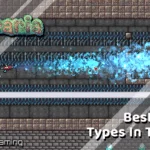Games with a hand-drawn aesthetic are often some of the most charming. Don’t Starve, Hollow Knight, Cuphead, and the list goes on. That aesthetic – which doesn’t necessarily conform to one art style – just feels more personal. It just tells you something about the game and the love its developers put into it. No exception to the rule, Retro Machina, is definitely charming. Exploring the dysfunctional world and visually satisfying of Retro Machina is an indulgent task, that’s unfortunately masked by questionable design decisions and poorly executed mechanics. So, in this Retro Machina review we’ll be taking a look at how this game came so close to greatness only to fall down before the summit.
Retro Machina Review: What Is It?
Retro Machina is an exploration puzzle game that is based around exploring the ruins of mankind. The game’s underlying (and main) narrative is taken on as you, a defective robot, get exiled from the city and start looking for a way to fix yourself.

The game is not the easiest to describe, but it’s simple to understand. As you begin your quest you will struggle through puzzles, fights, and lots of map navigation to piece together the fall of humanity. And, these 3 together make up the bulk of the game’s mechanics.
However, the main shtick of the game is the way you can mind-control other robots and automatons. The enemies that you fight along your way also happen to be the jigsaw pieces to your puzzle. You can use enemies to fight each other, explore the way ahead, or -most importantly – help you solve puzzles. Of course, each type of automaton has its own attacks and attributes that make the puzzles get progressively more difficult the more enemies you discover. So, cooperation with these robots will form a good chunk of your time with Retro Machina.
A Well Oiled Machine
While that does not sound like a lot, the game does well to utilize these easy-to-understand mechanics. The puzzles are creative, and, from my own experience, they never got repetitive or overwhelmingly frustrating.

In fact, puzzles were the highlight of the game for me. I was excited every time I hit another puzzle section. I always knew the difficulty of the puzzles would come from the developers’ creativity, not from deliberately hidden information. If I ever failed a puzzle, I knew it was my fault and I was not punished too harshly for it.
While puzzles were what I enjoyed most about the game, what kept me stringed along was the game’s narrative. I’m a sucker for subtle storytelling that drops hints all across the game- I absolutely loved Narita Boy for that. Similarly, Retro Machina kept me looking for breadcrumbs all through my time exploring the game. While the story itself is nothing groundbreaking, it is solid, intriguing, and – most importantly – told in an engaging fashion.
If it wasn’t obvious yet, what makes this game stand out is its visuals. The art in this game is absolutely gorgeous. From the hand-drawn cutscenes to the vintage and art deco styled postcards and banners, everything in this game is designed to absolute perfection. The desolate environments of the game were just enough to feel lonely and somber, yet not emotionless. If for nothing else, Retro Machina is worth playing just to witness the amount of love the game’s developers pumped into it.
No Malfunctions, But Definitely Clunky
With that said, extended portions of the game make you feel that you really are only playing for the excellent art direction. It’s unfortunate that, despite the game’s shiny visuals and creative puzzles, a large portion of the game is incredibly frustrating.

My biggest gripe with this game is, unfortunately, the – arguably – biggest part of the game. Simply put, combat in Retro Machina is incredibly forgettable. The game’s entire combat system revolves around a single three-move combo that your robot can perform. But what about controlling other automatons? Well, it’s not really practical. Unfortunately, the game’s most interesting mechanic is virtually useless. The time it takes to switch to automatons is way too long to use effectively. Additionally, the clunky controls makes it near impossible to effectively run away with your robot and simultaneously use your automaton to fight for you.
But even when you are not in a fighting arena, you are not safe from frustration. Retro Machina, for some reason, involves a lot of backtracking. While explicit puzzles are a lot of fun, the puzzle of traversing your way through the map is not. It is boring and long and, most of the times, incredibly confusing. The long treks give you a chance to take in the scenery and backgrounds but that is not much of a consolation.
Verdict
The first glance I had at this game, I was absolutely floored. I thought I will be going back to write only praise in this Retro Machina review. However, I may have judged it too soon. The gorgeous visuals, creative puzzles, and engaging plot make for great game; however, combat and exploration make the good moments few and far between.
Retro Machina is still worth playing because the good parts are really good. If you’re quickly frustrated you should look elsewhere. But, If you are a fan of the genre, you’ll be able to still enjoy the gems beneath the thick layer of clunk.
If this Retro Machina review got you interested in exploring the beautiful world crafted by Orbit Studio, make sure to check the game on Steam, Nintendo Switch, PS4, or Xbox One
This review is based on the PC version of Retro Machina. The key was provided by Super.com











